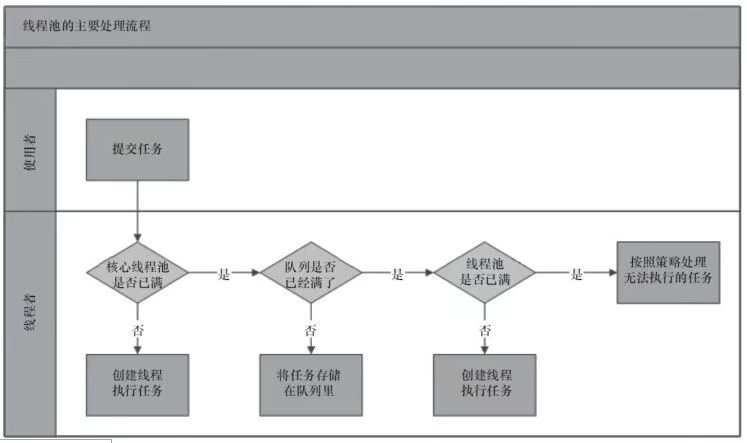Java线程池
说说进程和线程
进程的引入
多道程序设计允许多个程序进入内存运行,提高CPU利用率和效率,为了区分进入内存的不同程序,引入了“进程”概念。
进程是具有独立功能的程序关于某个数据集合上的一次运行活动。是系统进行资源分配和调度(不支持线程机制时)的独立单位,每个进程分配了独立的地址空间。
线程的引入
进程切换开销大,且进程内部需要并行实现不同功能,如浏览器进程需要在播放视频时下载文件,由于线程间切换通信更快,无需经过内核(因为进程内共享内存和文件),因此引入线程,作为调度的基本单位。
在windows中,线程作为分配CPU的基本单位,如果线程数不大于CPU核数,任务并行运行,大于CPU核数时,任务并发运行。
为什么要使用多线程
提高CPU和IO设备的利用率,在单核上,当一个线程因为IO等原因被阻塞时,可以切换到另一个线程执行任务,不会因为阻塞而浪费时间,在多核上,一个核可以执行一个线程,因此只有多线程才能发挥多核的优势。
进程的生命周期和状态
就绪、运行、阻塞。其中只有就绪和运行可以双向转换。
线程的生命周期和状态

线程池又是什么
如果有一个待执行的任务,就为其新建一个线程去执行它。这种策略叫做“每任务每线程”,这种策略具有很大的缺陷:
- 线程的生命周期需要开销
- 线程大于CPU核数时,多余的空闲线程会占用内存
- 受物理因素限制,无限制创建线程会引起Out Of Memory错误
在面临高负载情况时,以上缺陷都会暴露出来,因此将线程“池化”,作为一种可以调节控制的资源进行使用,能够让使用多线程的程序性能平缓的劣化,而不是程序快速崩溃导致不可用,维护了高可用性。
如何使用线程池
执行策略
- 任务在什么线程中执行
- 什么执行顺序
- 最多多少个任务并发
- 最多多少个任务等待
- 系统过载应该放弃哪个任务、如何通知
- 任务执行前和结束后做哪些处理
工作流程

创建线程池的静态工厂方法
newFixedThreadPool
1
2
3
4
5public static ExecutorService newFixedThreadPool(int nThreads) {
return new ThreadPoolExecutor(nThreads, nThreads,
0L, TimeUnit.MILLISECONDS,
new LinkedBlockingQueue<Runnable>());
}定长线程池,到达最大长度不再变化,等待队列无限长
newCachedThreadPool
1
2
3
4
5public static ExecutorService newCachedThreadPool() {
return new ThreadPoolExecutor(0, Integer.MAX_VALUE,
60L, TimeUnit.SECONDS,
new SynchronousQueue<Runnable>());
}创建可缓存无限制数量的线程池,如果线程中没有空闲线程池的话此时再来任务会新建线程,如果超过60秒此线程无用,那么就会将此线程销毁。简单来说就是忙不来的时候无限制创建临时线程,闲下来再回收
newSingleThreadExecutor
1
2
3
4
5
6public static ExecutorService newSingleThreadExecutor() {
return new FinalizableDelegatedExecutorService
(new ThreadPoolExecutor(1, 1,
0L, TimeUnit.MILLISECONDS,
new LinkedBlockingQueue<Runnable>()));
}线程数量为1,按规定的顺序(LIFO,FIFO,优先级)执行任务
ScheduledThreadPoolExecutor
1
2
3
4public ScheduledThreadPoolExecutor(int corePoolSize) {
super(corePoolSize, Integer.MAX_VALUE, 0, NANOSECONDS,
new DelayedWorkQueue());
}创建固定大小线程池,支持定时及周期性执行任务。
使用ThreadPoolExecutor
《阿里巴巴Java开发手册》中提到,线程池不允许使用Executors创建,而是通过ThreadPoolExecutor方式,这个方法是Executor框架的底层实现,可以更加明确线程池的运行规则,避免资源耗尽的风险。
- FixedThreadPool和SingleThreadPool的队列长度为Integer.MAX_VALUE,可能会导致大量请求堆积导致OOM
- CachedThreadPool和ScheduledThreadPool会创建大量线程,导致OOM
ThreadPoolExecutor构造方法
1 | public ThreadPoolExecutor(int corePoolSize, |
- corePoolSize:核心线程数量
- maximumPoolSize:线程池中运行存在的最大线程数
- keepAliveTime:存在线程数量大于核心线程数时,超过的此时间的空闲线程会被销毁
- unit:时间单位
- workQueue:当前线程池没有线程为任务提供运行服务时,任务的等待队列
- threadFactory:自定义的线程,实现了threadFactory接口
- handler:等待队列已经满后,任务的拒绝策略
使用示例
一个使用线程池对Web服务器发起10000次http请求的程序。
1 | import httpMethod.HttpRequest; |
更多细节
参考
- Java并发编程的艺术(2015).机械工业出版社
- Java并发实战(2012).机械工业出版社
- 如何优雅使用线程池